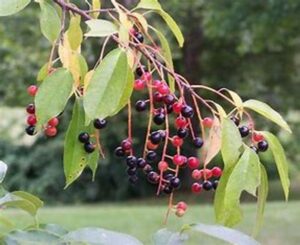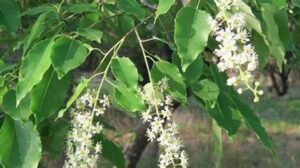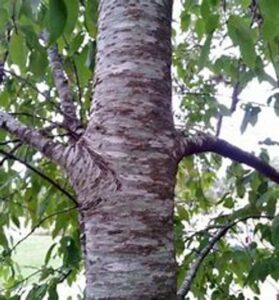Escarpment Black Cherry
by CMG Betty J
Escarpment Black Cherry, Prunus serotina var. eximia, is a true Texas native. An isolated and distinct variety of black cherry, (Prunus serotina), it only grows in the calcareous soil of the Edwads Plateau in Central Texas. It prefers full sun on the slopes of canyons and on flood plains and can be distinguished from other cherry varieties by its dark green leaves which are almost hairless and have toothed edges. The 3-to-5-inch leaves change color in autumn providing a vivid display of golden yellow that contrasts well with the evergreen Ashe juniper and Live Oak trees with which it commonly grows. Trees may grow to 50’ tall.
The flowers appear in early spring after the leaves have sprouted. Graceful racemes, (simple elongated stems of small flowers), up to 6 inches long support white half-inch flowers that hang among the foliage in March and April. The flowers are the larval host to the Eastern Tiger Swallowtail and Viceroy butterflies and the Silk, Promethea, Small-eyed Sphinx, Wild Cherry Sphinx, and Banded Tussock moths. Small, purple-black fruits with thin skins and large stones develop soon after the blooms. The cherries may be bitter or sweet and are a good source of food for birds and other wildlife. Although the fruit is edible, all other parts of the tree are poisonous if eaten, including the seeds. Stems, leaves and seeds are particularly toxic to humans and other herbivorous mammals.
Attractive bark and branches make the Escarpment Black Cherry tree an appealing choice for residential landscaping. Younger bark is silver with gray bands that matures to a dark, rough texture. The dark red wood is prized for its beauty and strength and is often used to make furniture.
Propagation is by hard or softwood cuttings, root cuttings, or from seed, although summer semi-hardwood cuttings are most successful. Trees are available commercially. Routine landscape maintenance should include some watering during a drought to prevent leaf drop. Pick up fallen stems and leaves if you have grazing animals to prevent accidental ingestion of the poisonous parts.

Black Cherry Fruit

Black Cherry Blossoms

Black Cherry Bark